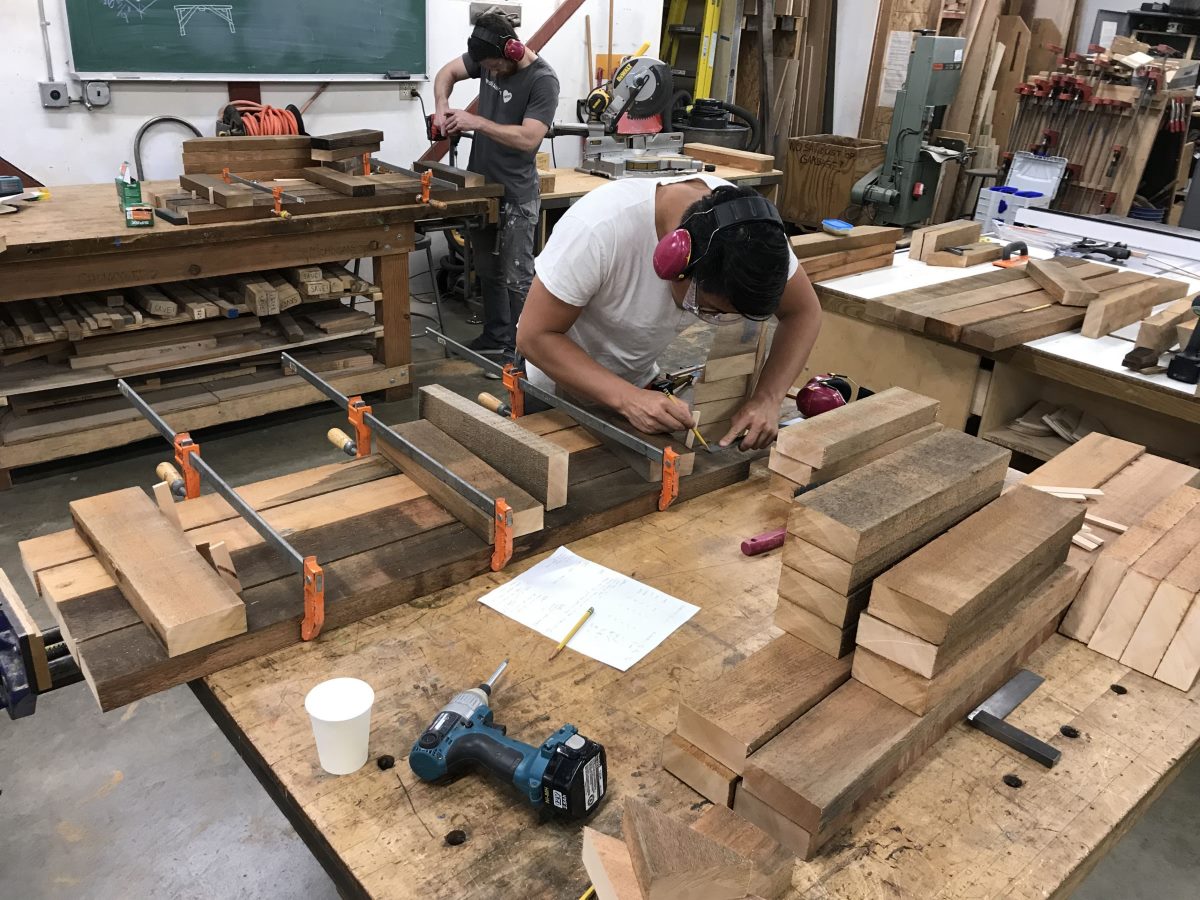

Articles
How To Get Into Woodworking As A Job
Modified: January 8, 2024
Discover the step-by-step articles to help you jumpstart your woodworking career. Learn essential techniques and tips to excel in the woodworking industry.
(Many of the links in this article redirect to a specific reviewed product. Your purchase of these products through affiliate links helps to generate commission for Storables.com, at no extra cost. Learn more)
Introduction
Welcome to the exciting world of woodworking! If you have a passion for creating beautiful and functional pieces from wood, then pursuing woodworking as a job could be a rewarding career choice. Woodworking allows you to unleash your creativity, work with your hands, and produce items that can be cherished for generations.
Whether you’re an aspiring woodworker looking to turn your hobby into a profession or considering a career change, this article will guide you through the process of getting into woodworking as a job. From understanding the basics to building your skills and even establishing a woodworking business, we will cover the essentials to set you on the path to success.
Woodworking is a diverse field that encompasses various disciplines, including furniture making, cabinetry, wood carving, and more. It offers a range of opportunities for expression, craftsmanship, and entrepreneurship. Before diving into the world of woodworking, it’s important to have a solid foundation in the basics.
Understanding the different types of wood, their properties, and how to select the right wood for your projects is crucial. Additionally, familiarizing yourself with the various woodworking tools and equipment will be essential, as they will be your trusted companions throughout your woodworking journey.
Setting up a dedicated woodworking workspace is vital for efficiency, organization, and safety. A well-equipped and organized workshop will not only make your tasks easier but also enhance your overall productivity. Proper ventilation and lighting, as well as adequate storage for tools and materials, are key considerations when creating your woodworking space.
Learning different woodworking techniques will allow you to expand your skillset and tackle a variety of projects. From joinery and dovetailing to carving and shaping, mastering these techniques will enable you to bring your creative visions to life. Additionally, it’s crucial to prioritize safety in woodworking, as working with power tools and sharp objects can pose potential risks. Familiarize yourself with safety practices, such as wearing protective gear and using tools properly, to ensure a secure work environment.
Key Takeaways:
- Embrace the learning process, start with simple projects, and gradually expand your woodworking skills to create unique and remarkable pieces with patience and attention to detail.
- Prioritize safety, build confidence through practice, and explore diverse woodworking projects to develop a thriving woodworking business and showcase your craftsmanship.
Read more: How To Get A CAD Job
Understanding the Basics of Woodworking
Woodworking is a craft that involves shaping and manipulating wood to create functional and decorative objects. Before diving into the world of woodworking, it’s important to have a solid understanding of the basics.
First and foremost, familiarize yourself with different types of wood. Understanding the characteristics of various wood species will help you choose the right material for your projects. Some popular wood types include oak, maple, walnut, and cherry, each with its own unique grain pattern, hardness, and color.
Next, acquaint yourself with the basic woodworking tools. Essential hand tools include a chisel set, handsaw, coping saw, mallet, and block plane. Power tools such as a table saw, jigsaw, router, and drill will also be indispensable in your woodworking arsenal. Learn about each tool’s function, how to use it safely, and how to maintain it properly.
When starting out, it’s best to begin with simple woodworking projects to hone your skills. These can include building basic furniture like a bookshelf or a small table, or creating simple wooden boxes. Starting small allows you to develop fundamental techniques such as measuring, cutting, and sanding, before moving on to more complex projects.
Practice is key in woodworking. As you gain confidence, challenge yourself with more advanced projects that involve intricate joinery or creative design elements. The more you practice, the better you will become at understanding wood characteristics, working with different tools, and troubleshooting any issues that may arise during the process.
Working with wood also requires an understanding of wood finishes. Finishes not only add aesthetic appeal to your projects but also provide protection against moisture and wear. Common wood finishes include stains, varnishes, and oils, each offering a different look and level of protection. Experiment with different finishes to find the one that suits your projects best.
Lastly, don’t underestimate the importance of patience and attention to detail in woodworking. Precision is key, whether it’s measuring and marking your wood accurately or ensuring tight fits during assembly. Take your time, double-check your measurements, and make adjustments as needed. These small details can make a big difference in the final outcome of your projects.
By understanding the basics of woodworking, you will lay a solid foundation for your journey as a woodworker. As you become more comfortable with the tools, materials, and techniques, you can explore more advanced projects and even develop your own unique woodworking style. So, embrace the learning process, enjoy the journey, and let your creativity flourish in the world of woodworking.
Acquiring Essential Woodworking Tools and Equipment
Now that you have a basic understanding of woodworking, it’s time to acquire the essential tools and equipment that will be your trusted companions in your woodworking journey. Having the right tools not only ensures that you can work efficiently but also allows you to achieve precise and professional results.
Here are some essential woodworking tools and equipment to consider:
- Workbench: A sturdy workbench is the foundation of any woodworking shop. It provides a stable surface for various woodworking tasks, such as cutting, assembling, and sanding.
- Hand Tools: Invest in a good set of hand tools that includes essential items like chisels, handsaws, planes, hammers, screwdrivers, and measuring tools like a tape measure and combination square. These tools will be your go-to for precise cutting, shaping, and joining wood.
- Power Tools: Power tools add speed and efficiency to your woodworking projects. Consider including a table saw, miter saw, router, power drill, and orbital sander in your collection. These tools can handle a wide range of tasks, from rip cutting and angled cuts to creating decorative edges and smoothing surfaces.
- Safety Equipment: Safety should always be a top priority in woodworking. Invest in safety equipment like safety glasses, ear protection, a dust mask, and a first aid kit. Additionally, consider getting a fire extinguisher and having a well-maintained fire alarm in your workshop.
- Clamps and Vises: Clamps are essential for holding workpieces securely during cutting, gluing, or assembling. Look for a variety of clamps, including bar clamps, pipe clamps, and spring clamps, to accommodate different woodworking needs. A bench vise is also handy for holding pieces steady while working.
- Sharpening Tools: Keeping your tools sharp is crucial for achieving clean and precise cuts. Invest in sharpening tools such as sharpening stones or honing guides to maintain the sharpness of your chisels, plane blades, and other cutting tools.
When acquiring tools, quality should be a priority over quantity. Invest in high-quality tools that are built to last and perform consistently. While they may be more expensive initially, they will save you time, frustration, and money in the long run.
Consider researching and comparing different brands and models before making your purchases. Reading reviews and seeking recommendations from experienced woodworkers can help you make informed decisions about which tools to invest in.
As your woodworking skills progress, you may find that your tool collection needs to expand. However, starting with the essentials mentioned above will provide you with a solid foundation for your woodworking projects.
Remember to take care of your tools by storing them properly, cleaning them regularly, and following the manufacturer’s instructions for maintenance. This will help prolong their lifespan and ensure that they continue to perform at their best.
A well-equipped workshop with the necessary tools and equipment will empower you to bring your woodworking ideas to life with precision and craftsmanship. So, gather your tools, set up your workspace, and get ready to embark on an exciting journey in the world of woodworking.
Setting up a Woodworking Workspace
Creating a dedicated woodworking workspace is essential for both efficiency and safety. A well-organized and properly equipped workshop will not only make your woodworking projects more enjoyable but also contribute to better results.
Here are some key considerations when setting up your woodworking workspace:
- Space: Determine how much space you have available for your workshop. Ideally, you should have enough room to comfortably move around and work on your projects. If space is limited, consider utilizing a garage, basement, or shed, or even setting up a corner in your existing living space.
- Lighting: Adequate lighting is crucial in a woodworking workspace to ensure accurate cuts and avoid accidents. Natural light is ideal, but if that’s not possible, invest in bright LED lights or task lighting to illuminate your work area effectively.
- Ventilation: Woodworking can produce dust, fumes, and airborne particles that can be harmful to your health. Ensure good ventilation in your workshop by opening windows or using an air filtration system or extractor fan to maintain clean and breathable air.
- Workbench: Your workbench is the centerpiece of your woodworking workspace. It should be sturdy, flat, and at a comfortable working height. Consider a workbench with a vise to securely hold your workpieces during various tasks.
- Storage: Having an organized storage system for your tools, materials, and supplies is vital for efficiency and safety. Invest in shelves, cabinets, or drawers to keep your workshop clutter-free and to easily locate tools when needed.
- Power Outlets: Ensure that you have enough power outlets conveniently located throughout your workspace to accommodate your tools and equipment. Consider installing surge protectors to safeguard your valuable tools from electrical damage.
- Tool Placement: Arrange your tools in a logical and accessible manner, based on frequency of use. Keep frequently used tools within reach, while those used less often can be stored in cabinets or on shelves.
- Workshop Layout: Plan your workspace layout to optimize workflow and efficiency. Arrange your workbench, tools, and machinery in a way that allows for smooth movement between different workstations. Consider the flow of work from cutting and shaping to assembly and finishing.
- Safety Measures: Implement safety measures in your workshop to ensure a secure working environment. This includes having a first aid kit, fire extinguisher, and a clear emergency exit. Keep the floor clean and free of debris and use anti-slip mats to prevent accidents.
Remember to personalize your woodworking workspace to suit your preferences and working style. Add personal touches such as inspiring artwork, a comfortable chair, or a radio to enhance your woodworking experience.
Regular maintenance of your workspace is also important. Clean up after each woodworking session, dispose of waste properly, and keep your tools in good condition. This will create a more pleasant working environment and prolong the longevity of your tools.
By setting up a well-designed and functional woodworking workspace, you’ll have a dedicated area to pursue your passion and bring your woodworking projects to life. A well-organized and efficient workspace will not only make your woodworking endeavors more enjoyable but also contribute to the quality of your craftsmanship.
Learning Different Woodworking Techniques
Woodworking is a craft that offers a wide range of techniques to create beautiful and intricate pieces. Learning and mastering different woodworking techniques will not only enhance your skills but also open up new possibilities for creativity and craftsmanship.
Here are some key woodworking techniques to consider:
- Joinery: Joinery is the art of connecting two or more pieces of wood to create a strong and sturdy joint. Common joinery techniques include dovetail joints, mortise and tenon joints, finger joints, and box joints. Learning these techniques will enable you to create durable and visually appealing connections in your woodworking projects.
- Carving: Wood carving involves shaping wood by removing material to create intricate designs, patterns, or sculptures. There are various carving methods, such as relief carving, chip carving, and carving in the round. Developing carving skills will allow you to add decorative elements and unique details to your projects.
- Routing: Routing involves using a router to hollow out or shape wood. It is commonly used to create decorative edges, grooves, or intricate designs. Learning how to use a router and different router bits will give your projects a professional finish and add versatility to your woodworking capabilities.
- Turning: Woodturning is the art of shaping a spinning piece of wood on a lathe. With a lathe and appropriate tools, you can create a variety of cylindrical objects such as bowls, vases, and spindle legs for furniture. Learning woodturning will significantly expand your woodworking repertoire.
- Shaping and Smoothing: Shaping and smoothing wood surfaces is essential for achieving a polished and professional look. Techniques such as planing, sanding, and using a spokeshave or rasp can help you achieve smooth and even surfaces on your projects.
- Finishing: Applying a finish to your woodworking projects not only protects the wood but also enhances its appearance. Learning different finishing techniques, such as staining, varnishing, or applying oils, will allow you to achieve the desired color, shine, and level of protection on your finished pieces.
To learn these woodworking techniques, there are various resources available to you. Consider taking woodworking classes or workshops at local community colleges, trade schools, or woodworking associations. These hands-on learning experiences will provide you with guidance, feedback, and the opportunity to learn from experienced woodworkers.
Books, online tutorials, and instructional videos are also valuable resources. They offer step-by-step instructions, tips, and tricks to help you master specific techniques at your own pace. Joining online woodworking communities or forums can also provide a platform for sharing knowledge and connecting with fellow woodworkers who can offer guidance and advice.
Practice is key when learning woodworking techniques. Start with simple projects that allow you to apply and refine your newly acquired skills. As you gain confidence and proficiency, gradually take on more complex projects that push the boundaries of your abilities.
Remember, learning woodworking techniques is a continuous process. Embrace the journey of lifelong learning and always strive to improve your skills and explore new techniques. With dedication and practice, you will become a skilled woodworker capable of creating unique and remarkable pieces.
Read more: How To Get A Job In Construction
Practicing Safety Measures in Woodworking
When it comes to woodworking, prioritizing safety is paramount. Working with power tools, sharp objects, and potentially hazardous materials requires careful attention and adherence to safety measures. By following proper safety precautions, you can enjoy woodworking while minimizing the risk of accidents or injuries.
Here are some essential safety measures to practice in woodworking:
- Protective Gear: Always wear appropriate protective gear to safeguard yourself from potential hazards. This includes safety glasses or goggles to protect your eyes from flying debris, a dust mask to filter out harmful particles when sanding or working with wood dust, and hearing protection to reduce noise exposure.
- Proper Tool Usage: Familiarize yourself with the proper usage and handling of each tool before using it. Read the manufacturer’s instructions, consult instructional guides, or seek guidance from experienced woodworkers. Improper tool usage can lead to accidents or damage to the tool itself.
- Workspace Organization: Keep your workspace clean, organized, and free from clutter. This reduces the risk of tripping or knocking over tools and materials. Proper storage of tools not only prevents accidents but also allows for easy access when needed.
- Sharp Tools: Keep your cutting tools, such as chisels, saws, and blades, sharp. Dull tools can cause slipping or require excessive force, increasing the risk of accidents. Use sharpening tools or have your tools professionally sharpened regularly to maintain their sharpness.
- Electricity Safety: Ensure that all power tools and equipment are properly grounded. Inspect cords for any frays or damage, and never use tools with exposed wiring. When not in use, disconnect tools from power sources and unplug them. Avoid using power tools in wet or damp conditions.
- Fire Safety: Woodworking involves the use of flammable materials, such as sawdust and finishing products. Keep a fire extinguisher readily available in your workshop and know how to use it. Additionally, have a fire safety plan in place with clear emergency exits, and avoid smoking or using open flames in the workshop.
- Workpiece Stability: Secure workpieces firmly before working on them. Use clamps or vices to hold them securely in place. This prevents accidental movement and ensures that your hands are clear from potential danger zones while operating power tools.
- Tool Maintenance: Regularly inspect your tools for damage or wear. Replace any worn out or damaged parts immediately. Clean your tools after each use, and lubricate moving parts regularly to keep them in good working condition.
- Education and Training: Take woodworking classes, workshops, or courses to gain knowledge and skills from experienced woodworkers. Learn proper techniques, safety guidelines, and best practices. Continuously educate yourself on new safety standards and practices to stay up to date.
Remember, safety is an ongoing process and should be integrated into every aspect of your woodworking practice. Always remain alert, focused, and mindful of your surroundings. If you’re unsure about a specific technique, tool, or safety procedure, seek guidance from a knowledgeable source before proceeding.
By prioritizing safety, you can enjoy the art of woodworking with peace of mind, knowing you’ve taken the necessary precautions to protect yourself and those around you. Woodworking should be a rewarding and fulfilling experience, and practicing safety measures ensures that it remains enjoyable and accident-free.
Start by learning basic woodworking skills and techniques through online tutorials or classes. Build a portfolio of your work and consider an apprenticeship or working for a woodworking company to gain experience. Networking with other woodworkers and attending trade shows can also help you break into the industry.
Starting with Simple Woodworking Projects
Embarking on your woodworking journey can be both exciting and daunting. It’s important to start with simple projects that allow you to build your skills and confidence before taking on more complex endeavors. Simple woodworking projects not only provide a sense of accomplishment but also serve as a foundation for mastering basic woodworking techniques.
Here are some ideas for simple woodworking projects to get you started:
- Wooden Coasters: Create personalized wooden coasters by cutting small squares or circles from a piece of wood. Sand the edges and apply a protective finish to enhance their durability and appearance.
- Simple Shelf: Build a basic wall shelf using a plank of wood and brackets. This project allows you to practice measuring, cutting, and assembly while creating a functional piece for organizing and displaying items.
- Cutting Board: Construct a wooden cutting board by gluing and clamping together several strips of hardwood. Sand the surface smooth and apply a food-safe finish to protect the wood and give it a polished look.
- Picture Frame: Craft a wooden picture frame by cutting and joining four pieces of wood. Use mitered joints for clean and seamless corners. Sand the frame and apply a suitable finish to complement your chosen artwork or photograph.
- Birdhouse: Build a simple birdhouse using basic woodworking techniques. Cut and assemble pieces of wood to create a cozy shelter for feathered friends. Add a coat of paint or stain to protect the wood and make it visually appealing.
- Key Holder: Construct an easy-to-make key holder using a small block of wood and hooks or pegs. This project helps you practice drilling, sanding, and attaching hardware while providing a practical solution for organizing keys.
- Wooden Planter Box: Create a wooden planter box for your garden or patio. Cut and assemble pieces of wood to form a simple rectangular box. Apply a weather-resistant finish to protect the wood from outdoor elements.
- Tool Rack: Build a wall-mounted tool rack using a piece of plywood and dowels. This project allows you to practice layout, drilling, and organizational skills while providing a convenient storage solution for your hand tools.
When starting these projects, make sure to take accurate measurements, use appropriate tools, and follow safe woodworking practices. Take your time, pay attention to detail, and aim for precision in your cuts and assembly.
As you complete these simple projects, you will gain hands-on experience, become familiar with different woodworking techniques, and develop an understanding of wood properties and how they respond to different tools and finishes.
Remember, it’s okay to make mistakes and learn from them. Each project is an opportunity to grow and improve your skills. Don’t get discouraged by setbacks; instead, view them as valuable learning experiences.
As your confidence and skills grow, you can gradually move on to more challenging projects that involve intricate joinery, complex designs, or larger-scale pieces. The key is to start small, build a solid foundation, and let your passion for woodworking guide you on your journey.
Building Skills and Confidence
When it comes to woodworking, building skills and confidence go hand in hand. As you gain experience and practice, your skills will improve, leading to increased confidence in your abilities. Building both skills and confidence is essential for taking on more challenging and intricate woodworking projects.
Here are some key strategies for building skills and confidence in woodworking:
- Start with Foundation Skills: Mastering fundamental woodworking skills is crucial for building a strong foundation. Take the time to learn and practice basic techniques such as measuring, cutting, drilling, and sanding. These skills will serve as building blocks for more complex projects.
- Learn from Experts: Seek out opportunities to learn from experienced woodworkers. Take woodworking classes, workshops, or courses where you can gain insights, receive guidance, and learn valuable tips and tricks. Embrace the wisdom and expertise shared by those who have mastered the craft.
- Experiment and Explore: Don’t be afraid to step out of your comfort zone and try new techniques or materials. Challenge yourself with different woodworking projects that push your boundaries and allow you to expand your skill set. The more you experiment, the more you will learn and grow as a woodworker.
- Practice Regularly: Practice is the key to improvement. Set aside dedicated time for woodworking and make it a habit. The more you practice, the more familiar you become with your tools, materials, and techniques. Consistency in practicing will lead to noticeable progress over time.
- Work on Incremental Projects: Gradually increase the complexity and difficulty of your projects. Start with simple projects and gradually tackle more advanced ones as your skills and confidence grow. This allows you to build on your existing skills and take on new challenges at a manageable pace.
- Seek Feedback and Learn from Mistakes: Don’t be afraid to ask for feedback from experienced woodworkers or seek advice from online communities. Embrace constructive criticism and view mistakes as learning opportunities. Analyze your projects, identify areas for improvement, and implement these lessons in future projects.
- Document Your Progress: Keep a record of your woodworking journey by taking photos or notes of your projects. Reflecting on your progress over time will not only boost your confidence but also serve as a reminder of how far you’ve come. Celebrate your achievements, no matter how small they may seem.
- Share Your Work: Displaying or sharing your finished projects with others can be a great confidence booster. Whether it’s showcasing your work to friends and family or participating in woodworking exhibitions or online communities, receiving recognition and positive feedback can fuel your motivation and inspire further growth.
Remember that building skills and confidence in woodworking is a continuous journey. Embrace the process, enjoy each project, and celebrate your progress along the way. Woodworking is a craft that requires both technical proficiency and artistic expression, and as you hone your skills, your confidence will soar, allowing you to undertake even more ambitious and rewarding woodworking endeavors.
Expanding Your Woodworking Portfolio
As you gain experience and confidence in woodworking, expanding your portfolio allows you to showcase your skills, challenge yourself with new projects, and explore different styles and techniques. Building a diverse woodworking portfolio not only demonstrates your capabilities but also opens up opportunities for growth and recognition in the woodworking community.
Here are some strategies for expanding your woodworking portfolio:
- Explore Different Project Types: Expand your woodworking repertoire by tackling projects in different categories. If you’ve mostly worked on furniture, consider branching out into carving, woodturning, or cabinetry. Varying your project types will help you master a wider range of skills and techniques.
- Take on Custom Commissions: Challenge yourself by accepting custom woodworking commissions. Collaborating with clients to bring their unique ideas to life allows you to expand your craftsmanship and experiment with new designs and concepts. Custom projects also provide an opportunity to push the boundaries of your skill set.
- Experiment with Different Wood Species: Broaden your knowledge and expertise by working with a variety of wood species. Each wood type has its own characteristics, including grain pattern, hardness, and color. Experimenting with different woods will enhance your understanding of their properties and how they respond to various techniques and finishes.
- Learn New Techniques: Continuously seek to learn and develop new woodworking techniques. Attend workshops, watch instructional videos, and explore online resources to expand your skill set. Learning techniques such as marquetry, inlay work, or bent lamination can add a unique touch to your projects and set them apart.
- Push the Boundaries: Challenge yourself with ambitious projects that test your abilities. Set goals and aim for projects that push your limits, whether it’s a large-scale furniture piece or a complex joinery project. Embrace the learning process and the satisfaction that comes with successfully completing a challenging project.
- Add Personal Style: Develop your own woodworking style and signature. Experiment with different design elements, finishes, or incorporating unique features into your projects. Infuse your personality and creativity into your work to create pieces that are truly one-of-a-kind.
- Join Woodworking Communities: Engage with other woodworkers through local woodworking clubs, online forums, or social media platforms. Participate in woodworking challenges or collaborative projects to exchange ideas, gain inspiration, and receive feedback from fellow woodworkers. Connecting with a supportive community can provide valuable insights and networking opportunities.
- Showcase Your Work: Display your projects in exhibitions, craft shows, or galleries. Utilize social media platforms and create an online portfolio or blog to share your work with a broader audience. Building an online presence allows you to connect with potential clients or fellow woodworkers, opening up avenues for collaboration and recognition.
Remember, expanding your woodworking portfolio is a journey, and it’s important to enjoy the process. Each new project adds to your experience and expertise, helping you refine your skills and develop your own unique woodworking style. Embrace new challenges, continuously learn, and never stop pushing the boundaries of your craft. With each project, your portfolio will grow, showcasing your growth as a skilled and accomplished woodworker.
Establishing a Woodworking Business
If you have a passion for woodworking and want to turn it into a full-fledged business, establishing a woodworking business can be a fulfilling and rewarding endeavor. Running a successful woodworking business requires a combination of woodworking skills, business acumen, and a strong work ethic. Here are some key steps to consider when setting up your woodworking business:
- Define Your Niche: Determine the specific area of woodworking in which you will specialize. Whether it’s creating custom furniture, crafting wooden home decor, or offering woodturning services, identifying your niche will help you target your marketing efforts and establish a unique selling proposition.
- Create a Business Plan: Develop a comprehensive business plan that outlines your business objectives, target market, competitive landscape, pricing strategy, marketing plan, and financial projections. A well-planned business strategy will provide a roadmap for your woodworking business and help you make informed decisions.
- Set Up Your Workshop: Create a dedicated and well-equipped workshop that meets your business needs. Ensure you have ample space and the necessary tools and equipment to handle your projects efficiently. Consider the layout, storage solutions, and safety measures to optimize your workspace.
- Sourcing Materials: Determine where and how you will source your woodworking materials. Research and establish relationships with reliable suppliers who offer high-quality wood and other necessary materials at competitive prices. Building strong supplier relationships will ensure a consistent supply of materials for your projects.
- Pricing and Costing: Develop a pricing strategy that takes into account material costs, labor, overhead expenses, and desired profit margins. Conduct market research to understand industry pricing trends and ensure your pricing is competitive yet profitable. Regularly review and adjust your pricing as needed.
- Build a Portfolio: Assemble a portfolio showcasing your best work. High-quality photographs or physical samples of your projects will serve as a visual representation of your craftsmanship and help attract potential clients. Display your portfolio on your website, social media platforms, and in physical form at trade shows or exhibitions.
- Market and Promote Your Business: Develop a strategic marketing plan to reach your target audience. Utilize digital marketing strategies such as a professional website, social media presence, content marketing, and search engine optimization (SEO). Offline marketing approaches such as participation in craft shows, referrals, and collaborating with interior designers or contractors can also be effective.
- Customer Satisfaction and Referrals: Focus on delivering exceptional customer service and high-quality craftsmanship. A satisfied customer is more likely to become a repeat customer and refer your business to others. Gather customer feedback and testimonials to build a strong reputation and credibility within the woodworking community.
- Continuous Learning and Improvement: Stay updated with woodworking trends, techniques, and innovations. Invest in your professional development by attending workshops, taking courses, or joining woodworking associations. Continuously refine your skills and expand your knowledge to stay ahead in the industry.
- Legal and Financial Considerations: Ensure you comply with all legal requirements and regulations for establishing and running your woodworking business. This includes obtaining any necessary permits, licenses, and insurance coverage. Seek advice from a professional accountant or financial advisor to ensure your business remains financially healthy.
Remember, establishing a woodworking business takes time, dedication, and perseverance. It’s crucial to have a passion for woodworking and a commitment to delivering exceptional craftsmanship. By combining your woodworking skills with effective business strategies, you can turn your passion into a profitable and sustainable venture.
Conclusion
Embarking on a woodworking journey can be an incredibly fulfilling and rewarding experience. Whether you’re passionate about creating beautiful furniture, intricate wood carvings, or functional home decor, the world of woodworking offers endless possibilities for self-expression and craftsmanship. Throughout this article, we have explored the essential aspects of getting into woodworking as a job.
We began by emphasizing the importance of understanding the basics of woodworking, including different wood types, tools, and techniques. Acquiring the essential woodworking tools and equipment is crucial for setting yourself up for success in your woodworking endeavors. A well-organized and properly equipped woodworking workspace ensures efficiency, safety, and a pleasant working environment.
As you dive deeper into woodworking, learning different woodworking techniques becomes essential for expanding your skillset and tackling a variety of projects. Practicing safety measures throughout your woodworking journey protects you from potential accidents, ensuring a secure work environment.
Starting with simple woodworking projects allows you to build your skills and confidence gradually. By embracing the learning process and continually practicing, you can improve your woodworking abilities and take on more complex projects over time. Expanding your woodworking portfolio will help you develop your unique style, showcase your craftsmanship, and open up new opportunities.
If you’re passionate about turning your woodworking hobby into a business, establishing a woodworking business requires careful planning, attention to detail, and effective marketing strategies. By combining your woodworking skills with sound business practices, you can create a thriving woodworking business that brings joy to both you and your customers.
Whether you choose to pursue woodworking as a hobby, a career, or a business, remember that it’s a journey of continuous learning and growth. Embrace the challenges, celebrate your successes, and always seek to improve your skills. Woodworking is not just a craft; it’s a passion that allows you to create beautiful, lasting pieces of art from a simple piece of wood.
So, let your imagination soar, embrace the sawdust, and let your woodworking journey take you on a path of creativity, mastery, and fulfillment. Enjoy every moment and remember that the true joy of woodworking lies in the process, the satisfaction of creating something with your own hands, and the timeless beauty that wood brings to the world.
Frequently Asked Questions about How To Get Into Woodworking As A Job
Was this page helpful?
At Storables.com, we guarantee accurate and reliable information. Our content, validated by Expert Board Contributors, is crafted following stringent Editorial Policies. We're committed to providing you with well-researched, expert-backed insights for all your informational needs.














0 thoughts on “How To Get Into Woodworking As A Job”